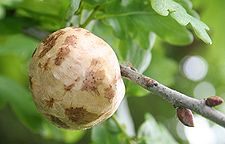- Oak Apple Day
-
Oak Apple Day or Royal Oak Day[1] was a holiday celebrated in England on 29 May to commemorate the restoration of the English monarchy, in May 1660. In some parts of the country, the day was also known as Shick Shack Day, Oak and Nettle Day[2] or Arbor Tree Day.
In 1660, Parliament declared 29 May a public holiday:
- "Parliament had ordered the 29 of May, the King's birthday, to be for ever kept as a day of thanksgiving for our redemption from tyranny and the King's return to his Government, he entering London that day." [3]
The public holiday, Oak Apple Day, was formally abolished in 1859, but the date retains some significance in local or institutional customs. It is, for example, kept as Founder's Day in the Royal Hospital Chelsea (founded by Charles II in 1681).
Traditional celebrations to commemorate the event often entailed the wearing of oak apples (a type of plant gall, possibly known in some parts of the country as a shick-shack, but see the article on its etymology in the external links) or sprigs of oak leaves, in reference to the occasion after the Battle of Worcester in September 1651, when the future Charles II of England escaped the Roundhead army by hiding in an oak tree near Boscobel House. Anyone who failed to wear a sprig of oak risked being pelted with bird's eggs or thrashed with nettles.[2]
These ceremonies, which have now largely died out, are perhaps continuations of pre-Christian nature worship. The Garland King who rides through the streets of Castleton, Derbyshire, at the head of a procession, completely disguised in a garland of flowers, which is later affixed to a pinnacle on the parish church tower, can have little connection with the Restoration, even though he dresses in Stuart costume. He is perhaps a kind of Jack in the Green and the custom may have transferred from May Day[2] when such celebrations were permitted again after having been banned by the Puritans.
Events still take place at Upton-upon-Severn, Northampton, Aston on Clun in Shropshire, Marsh Gibbon in Buckinghamshire, Great Wishford in Wiltshire when villagers gather wood in Grovely Wood, and Membury in Devon. The day is generally marked by re-enactment activities at Moseley Old Hall, one of the houses where Charles II hid in 1651.
At some Oxford and Cambridge halls a toast is still drunk to celebrate Oak Apple Day.
See also
- Arbor Tree Day
- Escape of Charles II
- Oak apple
- Royal Oak
- Push penny
References
- ^ "29th May was named Royal Oak Day 350 years ago by Act of Parliament. Royal Oak Day marks the Restoration of England’s Monarchy and celebrates our freedom from tyranny", royaloakday.org.uk
- ^ a b c Hole, Christina (1978). A Dictionary of British Folk Customs, pp114–115, Paladin Granada, ISBN 0-586-08293-X
- ^ Samuel Pepys, Diary June 1, 1660
External links
- royaloakday.org.uk
- House of Commons Journal Volume 8, 30 May 1660, Anniversary of the Restoration
- Pepys Diary 1 June 1660.
- English culture: Oak Apple Day
- Customs at Great Wishford
- Picture of an Oak Apple
- Possible etymology of shick-shack
- A 1915 film of Colonel Lyttleton inspecting the Chelsea pensioners on Oak Apple Day is preserved at the British Film Institute: screenonline: Topical Budget 197-1: Oak Apple Day (1915) (Only accessible to registered users).
Categories:- 1660 establishments
- 1859 disestablishments
- English folklore
- Festivals in England
- May observances
Wikimedia Foundation. 2010.


